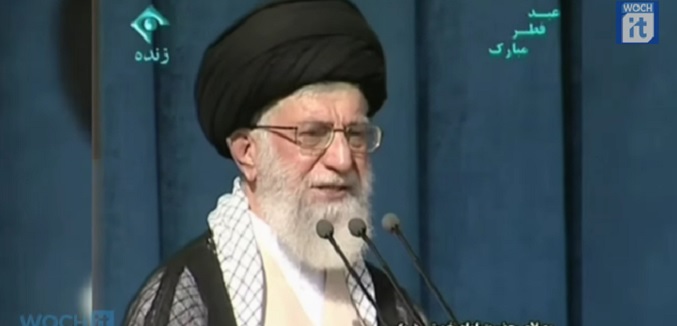The Obama administration was pressed on Tuesday to respond to statements from Iranian officials – most recently this weekend from the country’s Supreme Leader Ayatollah Ali Khamenei – doubling down on Iranian conditions for a nuclear deal that would among other things see the Islamic republic massively expand, rather than roll back, its uranium enrichment program. At Tuesday’s daily State Department press briefing, Fox News reporter James Rosen asked spokesperson Jennifer Psaki about a graphic posted on Sunday to Khamenei’s Twitter account that laid out several explicitly described “red lines” :
#Iran’s red lines in the #NuclearTalks pic.twitter.com/YEQOLeJphX
— Khamenei.ir (@khamenei_ir) October 12, 2014
The graphic reemphasized positions – most pointedly, the latter demand for an enrichment capacity of 190,000 separative work units (SWUs), at least 19 times over what Iran has now – that Khamenei published on his website in early July. The 190,000 figure was quickly cited and echoed by top Iranian nuclear officials, including via an Iranian-hosted PR-style webpage known to U.S.-based arms control analysts as one that conveys “quasi-official” Iranian government talking points.
The stance is almost by definition a nonstarter, moving as it does in the opposite direction of the basic Western position that Iran must limit rather than expand its nuclear program. Robert Einhorn, a former State Department special adviser for nonproliferation and often a prominent defender of the Obama administration’s diplomacy toward Iran, at the time noted tersely that Khamenei’s statements “seemed to widen” already-existing gaps between Tehran and the West.
Psaki responded to Rosen’s Tuesday question by suggesting that the Supreme Leader’s Twitter post may have been aimed at a domestic audience:
QUESTION: Without asking you to disclose the classified contents of these negotiations, has it been your observation that the redlines that were promulgated in this diagram have indeed been set by the Iranians and their delegation in the context of the talks, or are those redlines something that’s just on Twitter and elsewhere?
MS. PSAKI: I would just say there are a range of comments that have been made by Iranian officials. They have their own political audience, as we all know. Beyond that, I’m not going to speak to specifics of what’s going on behind the scenes, whether there – it’s on Twitter or not on Twitter or how consistent it is.
Administration officials have offered the theory before in response to intransigent English-language declarations made by Iranian officials and conveyed via Western media platforms.
Journalists had in the past openly mocked the notion, and Psaki’s response prompted veteran Associated Press correspondent Matt Lee to ask whether the State Department’s position was that “a tweet in English from the Iranian leader is aimed at an Iranian audience.” Tehran forbids its citizens from accessing Twitter.
[Photo: WochitGeneralNews / YouTube]




